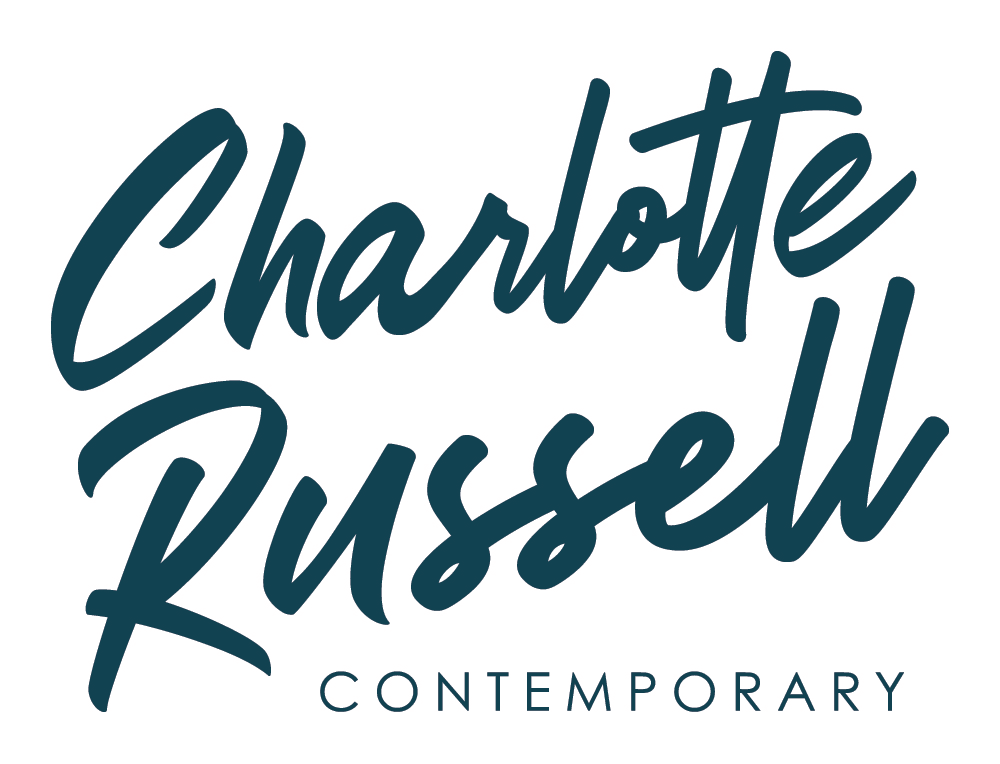-
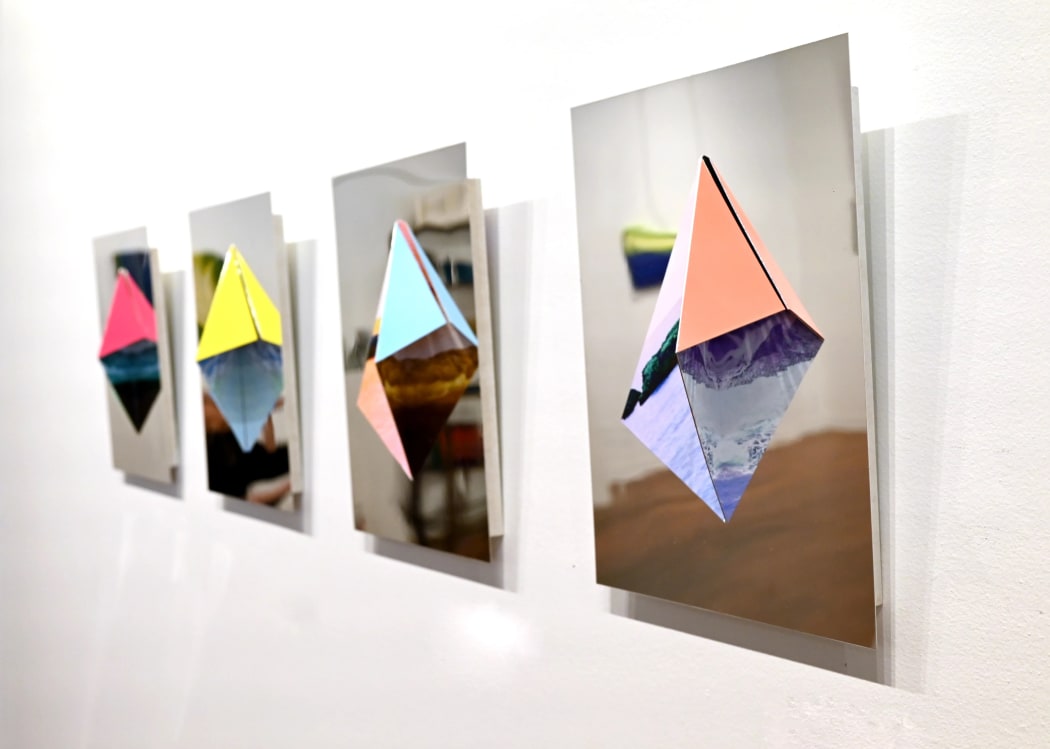 Learn about artist Mar Hester's unique process and approach to her photo-sculptures.
Learn about artist Mar Hester's unique process and approach to her photo-sculptures. -
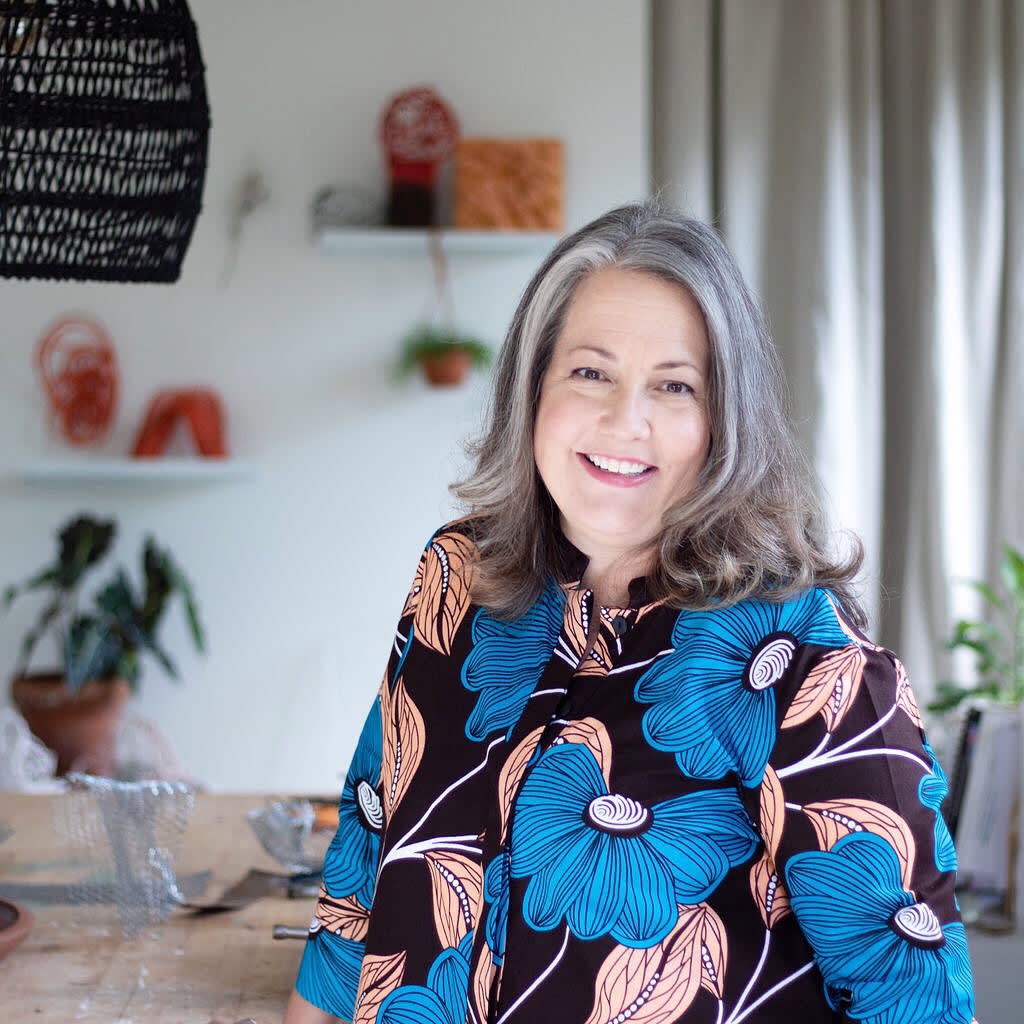 Photo by Studio Gray
Photo by Studio Gray -
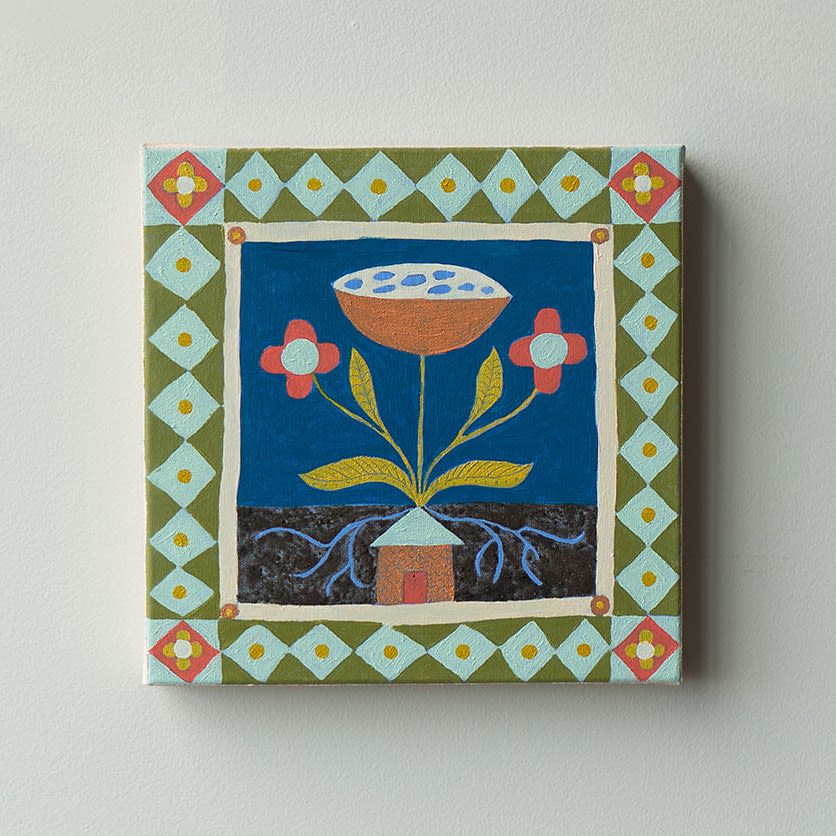 Lotus Seed Home, 2022Charlotte shares her thoughts on artist Meredith Walker
Lotus Seed Home, 2022Charlotte shares her thoughts on artist Meredith Walker -
 The Early Hours, Days, Weeks, 2021Charlotte shares her thoughts on mixed-media artist Kelly Sheppard Murray
The Early Hours, Days, Weeks, 2021Charlotte shares her thoughts on mixed-media artist Kelly Sheppard Murray -
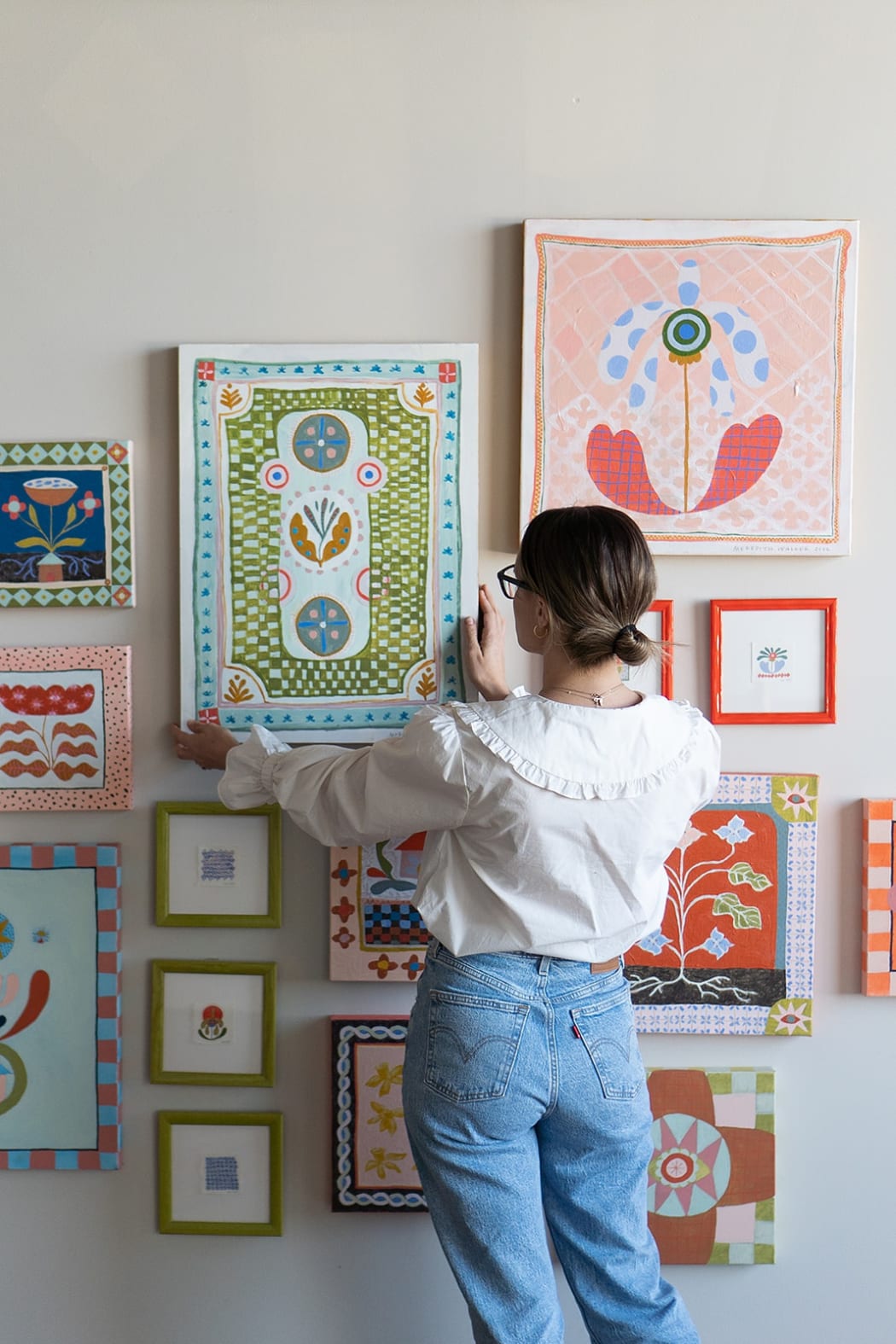
-
 Photo: Jennifer Hayward Photography
Photo: Jennifer Hayward Photography -
 y Jennifer Hayward Photography
y Jennifer Hayward Photography -
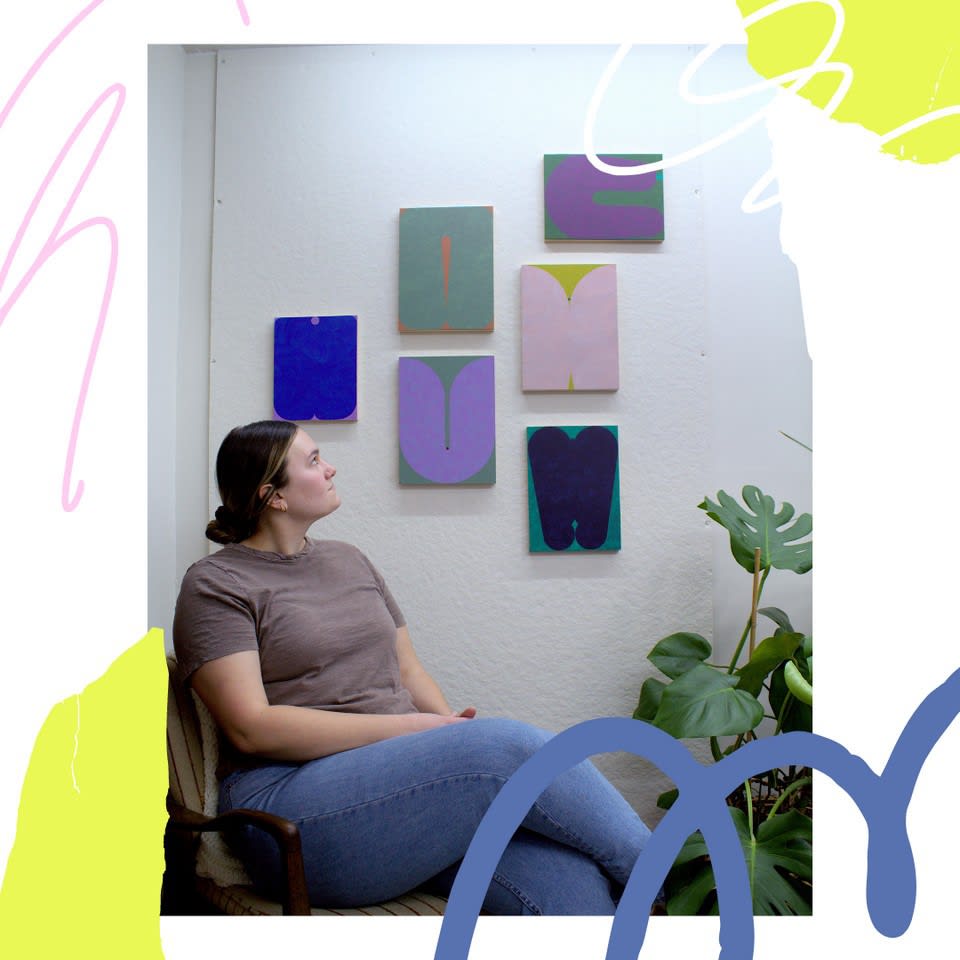
“This body of work really feels like an exploration of my place within the world. I always feel like the small dots that often show up in the work are little explorers, figuring out the terrain which surrounds them. I am also expanding on shape and scale in this body of work, trying to find how many iterations of these rounded off, elongated shapes I can come up with, and if I can begin to crop them differently to play around with the feeling of proximity in a new way.” - Emily Bartolone
-
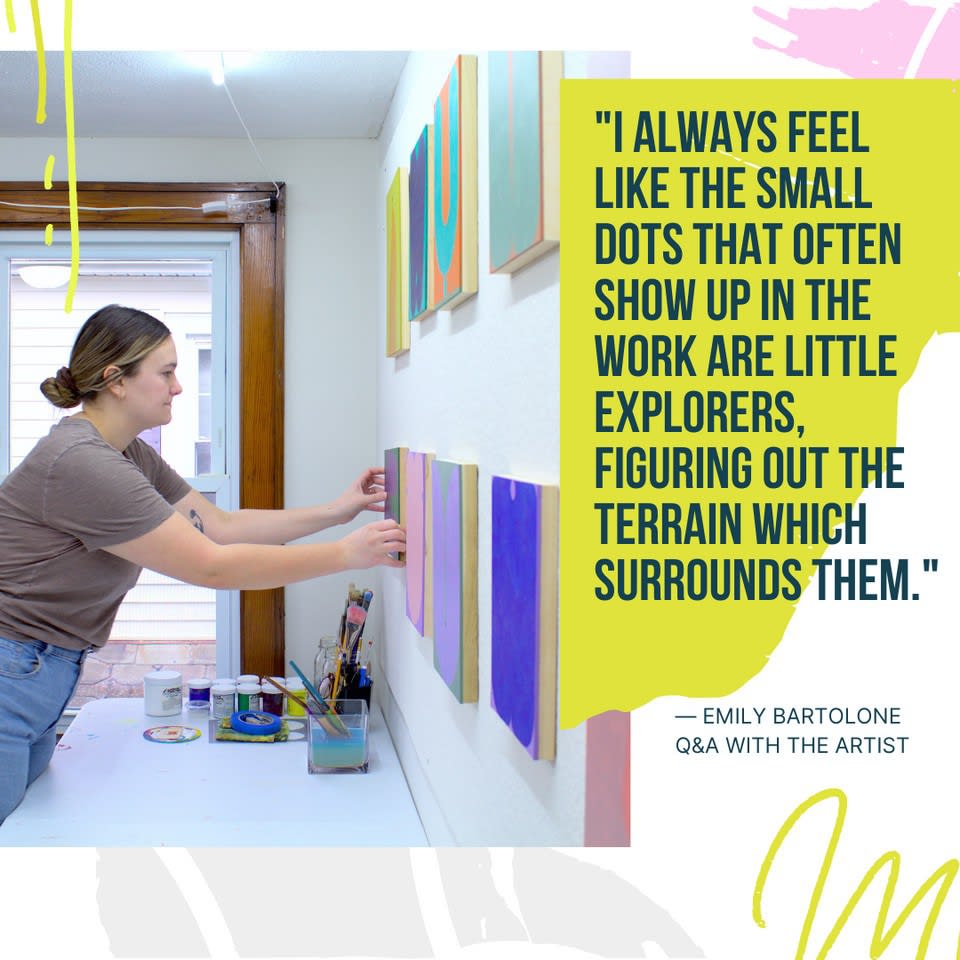
-
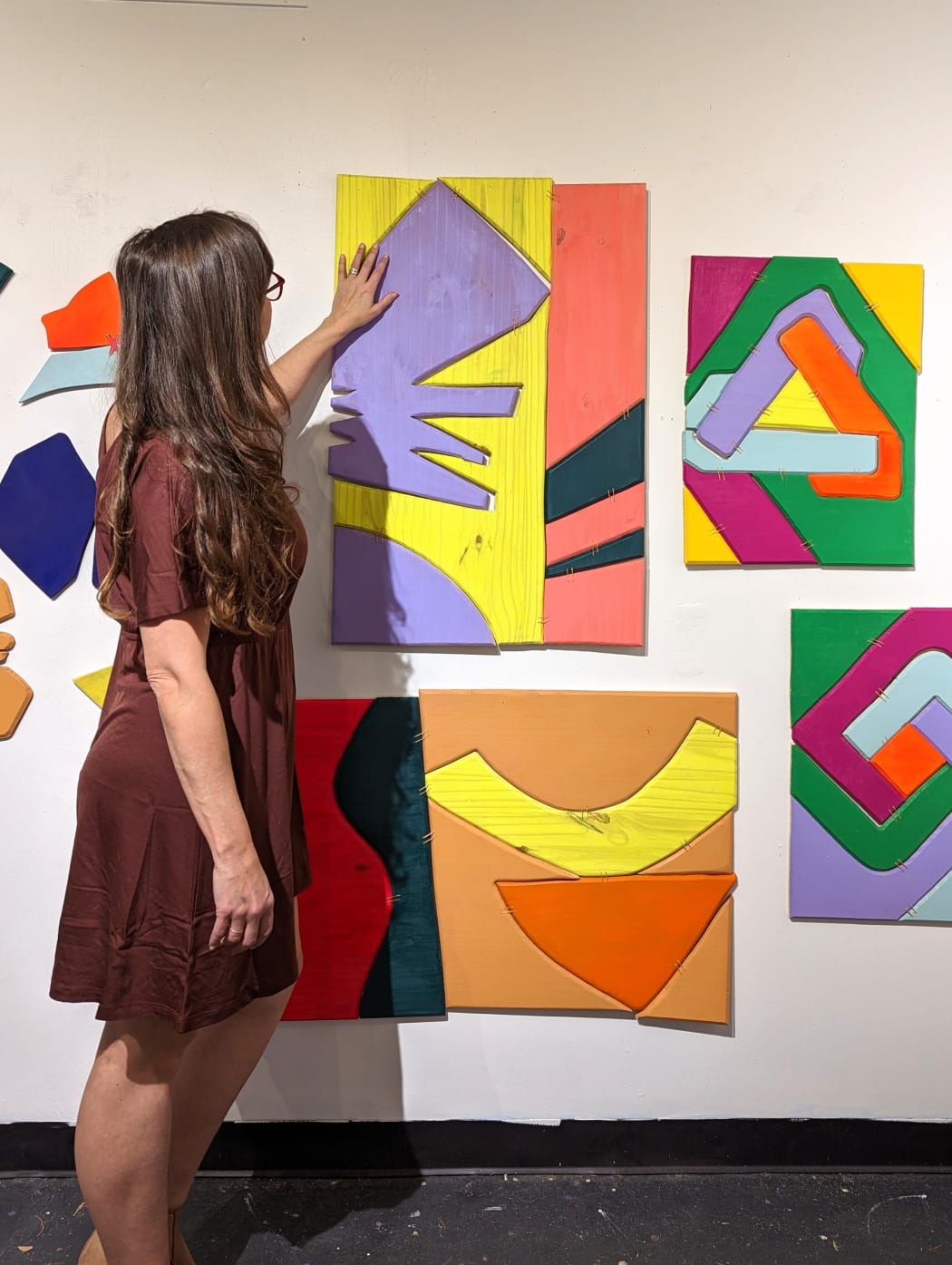
-

-
Where are you from and how does that affect your work?
I was born in Lumberton but grew up in the community of Greensboro, NC not far from here. I would like to think that my southern upbringing comes through in my practice with strong ties of family and community. As a young budding artist I was fiercely supported by my family and friends.
I would say my artistic voice has been built from layers of experience and places : from a remote island in Maine, some backroads of Georgia, a desert in Washington State, and from the many thunderstorms of North Carolina.
-
Where did you start as an artist?
My mother actually jokes that I came out of her womb creating. As a child, I would lock myself in my room and come out with pages of drawings. In Kindergarten my teachers let me stay up during nap time and featured my art at the end of the year. Through the support of teachers and family I was given the time and space to create work and at the age of 12 was doing realistic portraiture . I had my first exhibition at the age of 18 and that's all she wrote. Since then, I have had at least one exhibition a year since 1997.
There was never a conscious beginning.
-
Where do you currently live and work?
I currently live in Raleigh, NC and have a studio at Artspace, Studio 110. Come and see me!
-
What is your artistic process from start to finish?
My process involves small acts that batched create larger works - Sketch, paint, saw, sand, puzzle, balance, and sew. Repeat
-
Do you plan out your works before or let them take shape during your process?
With my sketchbook, as mentioned before I am always on the lookout for shapes but when I get to work on the wood it is an amalgamation of where the start of a sketch happens and where the paint on the wood takes it. Angles can change, size can vary. I don’t question the shapes that appear, I lean into a certain trust with the material. If I am working on installing in a specific space, I plan backwards, what is the space, how may pieces will I need, what are the sizes, what is the message, what is the pattern of traffic, what comes first, what do pieces do you leave with in your mind.
-
Tell me about your medium of choice. Is there a specific environment or material that's integral to your work?
A college professor of mine Greg Carter asked me if when I am making the work, does the idea come first, or does the material. And that always stuck with me. It allowed me the freedom to explore work the way that it is natural for me to explore work. I was trained at a very young age in perspective and realism by a wonderful woman and teacher Janet Dingeldein and so once I got to college I was ready to express ideas and not just material. Throughout the years, my work has always started with the idea with the medium following. The material in this body of work Woven Strangers is very specific to the message. Currently, I use plywood for its rigidity, lightness, and for woods inherent strength and warmth. This is known as composite wood and I think it lends itself quite nicely to the meaning because by definition it includse a range of different derivative wood products all of which are created by binding the strands, fibres or boards of wood together.
In my current work, I think the trinity of material: wood and its process, waxed thread, and color is integral to my work. Its my signature.
Paint - representative of breath, water, erosion, personality, obstacles, and time
Wood - as representative of strength, rigidity, and weight
Waxed thread - as binding, as movement, as play, as fragility
-
Let’s talk color - how do you decide your color choices?
Color ebbs and flows for me. For a time, I was combining contrasting colors, colors that allowed for a bit of chaos and spontaneity. But now I find myself leaning into grouping of color. For my last exhibition I made 30 pieces, in this grouping there were 6 groups of 5 images. Each grouping had a thematic color that I felt investigated the personality of one person who has donated life, and each of the 5 images were meant to represent the life donated- a heart, lung, eye, liver, and so on.
So I can gather color choices from lots of places. Often it will speak to me in the moment or from a mood.
For this particular collection I wanted the wood to come from one piece, the paintings to all be in harmony with each other.
-
Let’s talk about surface texture - how do you manipulate the surface?
I like to erase the trace of my hand so marks are made by soaking, staining, scraping, spraying, and sanding.
-
Where do you find inspiration?
I find inspiration everywhere. I carry my sketchbook with me and I find inspiration in outer and inner structures, in foundations, in geology, in the positive and negative space I see, in imagined minimal inner landscapes of our bodies. I like to look for balanced imagery and think about our inner landscape and how it is our foundation. Most shapes you see are organs set in minimal shapes. The message and meaning behind my work is about the double lung transplant I received three years ago and I am inspired everyday by people who continue to fight the good fight waiting for transplant. These works honor those who have chosen to donate life including my donor.
-
What motivates you to create?
It's not a matter of motivation necessarily but innate inner drive that I cannot turn off. I come by it naturally. Artwork is my voice, and so it is the articulation of my life.
-
How does your personal narrative play a role in your art making?
If you would look at my work over the years, narrative is at the center of my work. When my children were in the womb, I created a series called Fruits of our Labor and made realistic watercolors of bouquets, fruits, and vegetables all in thinking of growth and bounty. I did a lot of memory and grief pieces in unforgiving charcoal and in black pen when I was dealing with the loss of my brother. The narrative has always come first, and the material follows. I have found that artwork for me acts as Object as Vessel, a place to carry things that are too bug to carry on our own.
-
How does being a mother impact your art process?
When my twins were born, I physically felt myself divide into three people. I wasn’t just aware of self anymore, I became hyper-aware of two other beings and their everyday needs and operations. In a way I was born anew, my time wasn’t all my own anymore. Becoming a mother has helped to inform my joy and curiosity and has allowed a window of play and nonjudgement into my practice that wasn’t there before. It has also forced me to hyper-manage my time, given me the ability to pour myself into these vessels of moments, helped me to identify and ask for what I need, and to precisely direct my energy in ways I have not been able to do in the past. It has really solidified my practice.
-
Do you have a network of other artists, and how do they support you?
I'm deeply grateful for the support and encouragement of the community of artists that reside in the triangle as well as many relationships I have developed through technology around the country and world. In these relationships, I find support and encouragement.
I am personally all about community over competition.
-
Who are your biggest artistic influences?
Andrea Zittell, for her use of material and ideas around space. Andrew Wyeth for his grasp of mood. John Singer Sargent for his use of light and for his ability to capture a moment. Gerhard Richter for his many bodies of work and being able to look back and seeing the ties through them all. Teil Duncan and CJ Hendry for their craft, scale, and business practices.
-
How has your style changed over time?
It has changed quite a bit over time, we would need a whole another conversation for that. My work follows the idea of Object as Vessel. If you want to know more about this, come and see the experience/exhibition that I am creating for October of 2023 at the Greensboro Project Space.
-
Let’s talk about this body of work featured at Charlotte Russell Contemporary. What is this body of work about?
This work leans into my signature use of wood and thread, strength and fragility, but leans towards a more playful direction. Since this was a small capsule work, I thought of the theme of what a boy in high school, Noah Post, once told me.
Tie tight knots.
This work is a nod to my mother and to my brother and the pieces are inspired by the organ of the heart, but also playfully inspired by the theme of Valentine's. The wooden hearts in particular are meant to organically mimic Valentine's heart candy.
-
To title or not to title - how do you come up with the titles for your pieces?
Title! I embrace titles as they can add so much meaning and in this series Woven Strangers they are all titled with a similar method. Sometimes I will name a piece two people’s names to be literal, sometimes two things that live well together, sometimes two things that are in contrast to one another. In transplant there is joy, there is trepidation, there is hope, and there is fear. These pieces hold all of that. For example in past pieces, one piece is called Bubble and Gum to be playful whilst another one names an imagined someone who has lost their life but who has donated it and extended their life to another.
-
What do you hope viewers will take away when engaging with your pieces?
Mostly, I hope they walk away with joy, especially with this bright micro collection. Depending on what time and energy the viewer wishes to invest in the piece, there is always more to discover as well.
-
Which art trends inspire your current work?
I am absolutely inspired by the women of woodworking movement, the artist/mother movement, and the taking up space global movement through Thrive together.
-
Describe your most favorite artwork you have made of all time.
I have a few. There is one peony from my Fruits of our Labor series that firmly grasps the delicate fertility of pregnancy and birth. There is one painting when I was on oxygen from my series 12 -20, An Adult as Rest that captures a single breath and all the life contained within. Often the piece that stands out within a collection for me is going to be the one that solves a problem within the parameters I have set for myself to define the narrative.
-
Describe your dream project. If you could make anything, what would it be and why?
Currently, I am seeking out experiences and spaces with fabrication so that I can think larger scale. I just received the 2023 Artist Support Grant through the NC Arts Council/ United Arts for more power carving tools and will be attending a woodworking class at the NC State Craft Center in January/February.
Dream project is being able to continue to create this work and share it with my community. I am in the middle of writing a book and workshop about Object as Vessel and will be putting on an experience/exhibition at the Greensboro Project Space in October of 2023.
Thinking of dream spaces, I seek to be in more health spaces like hospitals and in larger museums such as today that encourage dialogue and discourse.
-
-

I am so thrilled to present my second exhibition of Hannah Surace’s work. In her latest pieces, Surace has expanded upon her use of color, unique texture, and bold graphic elements. This collection of large paintings and works on paper demonstrate what I love about Surace’s work the most: the use of recognizable iconography like hearts or stars that transport me back to my childhood doodling in the margins of my notebook.
Her process is all about collecting. She collects unique color combinations, different textures, and patterns. Each element invokes for her feelings of comfort or nostalgia. Then drawing on an iPad, Surace starts to digitally compose the work. Once settled with the formal composition, she loosely translates this digital image onto canvas.
It is the rich layering of her collection that make each work so visually interesting. Surace references her own personal history while simultaneously creating works that remind the viewer of their own personal history. This collection incorporates stars throughout various works. This star is a reference to her mother, a teacher, who let Surace help grade paper’s with a star.
Surace really knows how to create a rich surface. She picks an aspect of the composition to emphasize with texture. The texture is created through building of acrylic mediums, and the result Surace likens to sand or cake frosting adding an element of play to each piece.
Play is at the heart of this collection. I hope viewing this collection reminds you that art in its essence is playful and fun.
X, Charlotte Russell
-
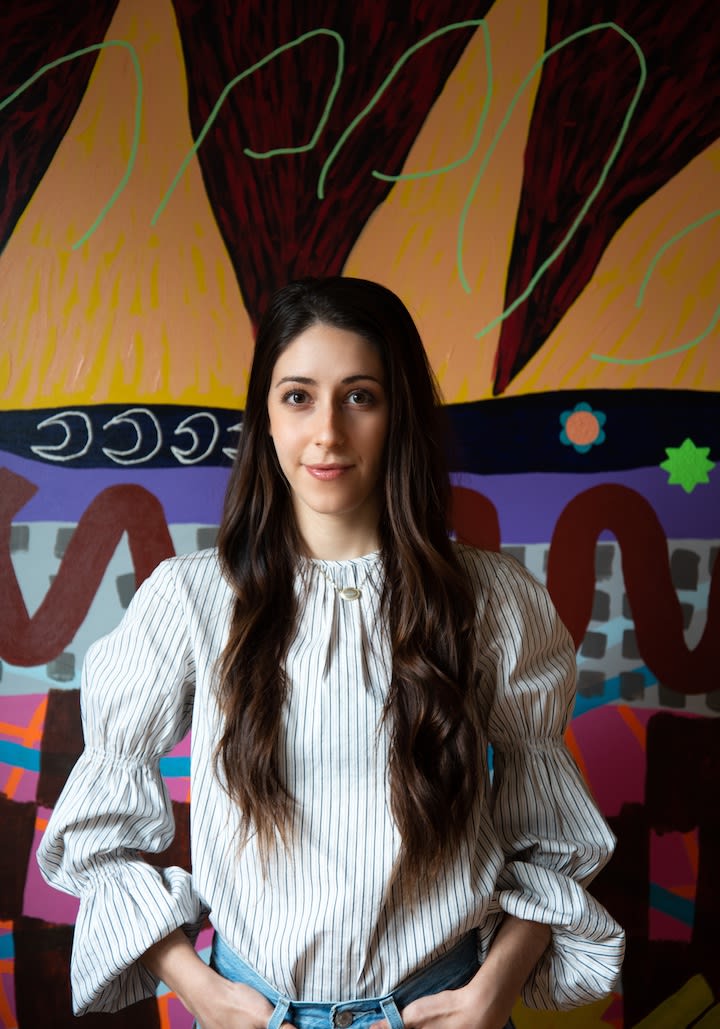
-
Where are you from and how does that affect your work?
I am originally from Northeastern Pennsylvania. My family still lives there, and it is very much where I consider home. Northeastern Pennsylvania is a blue-collar working-class environment, and although my work is not directly commenting on the social issues of this place, it is part of my experience and definitely influences my decision making and practice.
-
Where did you start as an artist?
I began college at Temple University in Philadelphia, Pennsylvania with my major undecided and gravitated towards the fine arts electives. It wasn’t until I took a glassblowing class and had a fantastic instructor that I realized I could make being an artist or arts educator my career. I eventually transferred to Moore College of Art & Design, an all-women’s art school in Philadelphia, and received my BFA. I then went on to receive my MFA in Sculpture from The Savannah College of Art & Design in Atlanta, Georgia.
-
Where do you currently live and work
I live and work in Salisbury, North Carolina. I am a full-time instructor in the Art & Design department at Rowan-Cabarrus Community College.
-
What is your artistic process from start to finish?
I collect images of color combinations, textures, and patterns that inspire me and invoke feelings of comfort or nostalgia. I draw on an iPad using those sources to create formal compositions. I draw digitally at this step because there is no risk involved and I can continuously change and edit. Once I arrive at a composition that I like I will decide on a scale and begin to translate the digital image onto canvas. I follow the digital sketch loosely, changing and adding to that original idea along the way. This process continues until I feel like the work is complete.
-
Do you plan out your works before or let them take shape during your process?
A little bit of both. I begin by drawing digitally and model my paintings from a digital sketch for the majority of the work, then towards the end I add to that original sketch until I feel like the painting is finished.
-
Tell me about your medium of choice. Is there a specific environment or material that's integral to your work?
I like the physicality of painting. It’s funny because the general composition usually comes together quickly for me, but the large size I like to work at forces me to slow down. So does the application of texture. Those processes take a long time and allow me to reflect and learn during the process. I am a relatively petite person and I like the challenge of making something bigger than me.
-
Let’s talk color - how do you decide your color choices?
Like I said before, I often pull from reference images or notes and sketches. A vintage Moroccan rug may have a color combination that I integrate into a painting.
-
Let’s talk about surface texture - how do you manipulate the surface?
I love texture. I often pick an aspect of the composition to emphasize with texture. I use acrylic mediums to build up an area. They often end up looking like cake frosting or sand. I think it is a fun surprise in the work, from a distance you may not realize or notice the texture, but once you get up close to the work it is a fun contrast and an additional visual layer.
-
Where do you find inspiration?
I find a lot of inspiration online. I grew up during the 90s and we got a computer when I was like 10 years old. I love saving images of interiors or fashion on Pinterest and a lot of my drawings and ideas have origins there. I am also inspired by lowbrow culture, and I like using materials or imagery that some might define as non-serious. I like incorporating imagery like stars, moons, or hearts into my paintings. They feel like what might be scribbled in the margins of a notepad with your crushes name or a star drawn on a graded paper. My mom is a teacher and used to let me help her by drawing the star on her tests.
-
What motivates you to create?
Staying busy in my studio motivates me to create. The more I make the more I am motivated to continue making. I am fortunate to have a job where I look at and talk about art all day long. Seeing my students inspired by art and motivated to make their work gives me motivation as well.
-
How does your personal narrative play a role in your art making?
I reflect on my own personal history and narrative when creating my work in hopes to better connect with others.
-
Do you have a network of other artists, and how do they support you?
I have a group of friends and mentors from my time in undergraduate and graduate school that are an incredible source of support. I also utilize Instagram to connect with artists. I think using social media as a way of connection and finding new artists is awesome, this has been particularly helpful throughout the pandemic.
-
Who are your biggest artistic influences?
I am always inspired by Julie Mehretu’s work. Experiencing the scale of her paintings in person is exciting and overwhelming. I am also inspired by the work of Hilma af Klint. Her use of color is so beautiful.
-
How has your style changed over time?
Visually my work has changed a lot over the years, but my interests and ideas have stayed the same and I really do see the thread throughout it all. I received my MFA in Sculpture in 2019 and was working almost exclusively three-dimensionally at the time. I eventually began to experiment more in painting and drawing and once I began working at a larger scale I fell in love with that process. I do believe that working three-dimensionally will make its way back into my practice at some point.
-
Let’s talk about this body of work featured at Charlotte Russell Contemporary. What is this body of work about?
This body of work began at the beginning of the pandemic. I had finished graduate school, moved to a new state, and started a new job. I got married and then the pandemic began. It came after a period of not making anything and feeling guilty about that. At the time I had nothing but time and was stuck inside, so I began generating a lot of work and experimenting. This body of work was born out of not fussing too much and letting go of expectations. In my statement I say that the work is about memory because I am purposefully collecting images of color combinations, textures, etc. that generate an emotional response. The source imagery is not necessarily important for the viewer to know about the work, it is just a part of my process. The work becomes a filter for all of it that at the end of the cycle speaks to personal history and experience. I know others can relate to that and that is where my interest lies.
-
To title or not to title - how do you come up with the titles to your pieces?
Trying to title a work used to be so stressful for me and made me feel kind of dumb for not automatically having some impressive name for my work. This is something I have worked on- not only with finding a title for my work but also the entire making process. It isn’t fun anymore if it is stressful or anxiety inducing, so I don’t let it be that way. It can be fun and silly. I sometimes name my paintings after music or podcasts I am listening to or just let imagery in the work dictate the title.
-
What do you hope viewers will take away when engaging with your pieces?
I hope my work generates happiness and allows people a place to reflect. I love when someone viewing my work says, “this reminds me of xyz..” I am always referencing things in my paintings that bring me comfort and joy and it is exciting when a person viewing the work has a similar reaction.
-
Which art trends inspire your current work?
Artists who are making in an authentic way.
-
Describe your most favorite artwork you have made of all time?
I think the last thing I make is always my favorite.
-
Describe your dream project. If you could make anything, what would it be and why?
I would love the ability to spread out and experiment with working even larger than I do now. My studio is in my house, and I am very limited with space. I really can only have two large paintings out to be worked on at a time. I would love to be able to experience the making process and my work in a bigger environment.
-
-

At home with Charlotte
Step inside Charlotte's artfilled home.My home is my greatest source of inspiration. Each artwork hanging in my home tells the story of not only the artist, and their work, but is now part of my story.
-

-

-
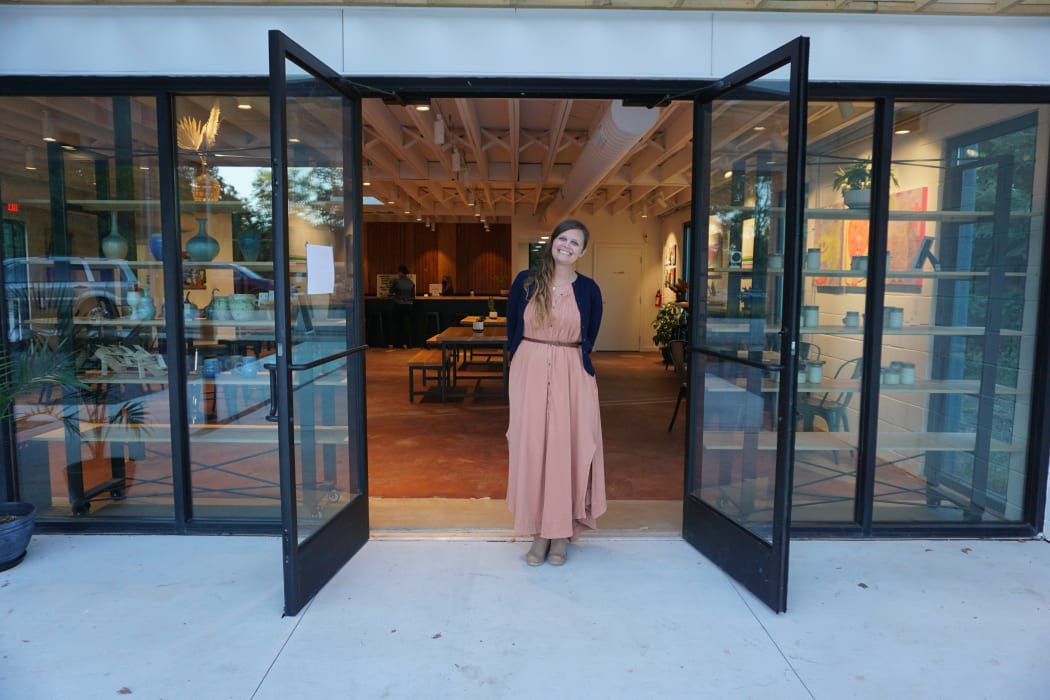
Jean Gray Mohs Artist Talk at Hartwell
October 19, 2021Jean Gray Mohs held a great talk about her mixed media works on view at Hartwell on October 19, 2021.
